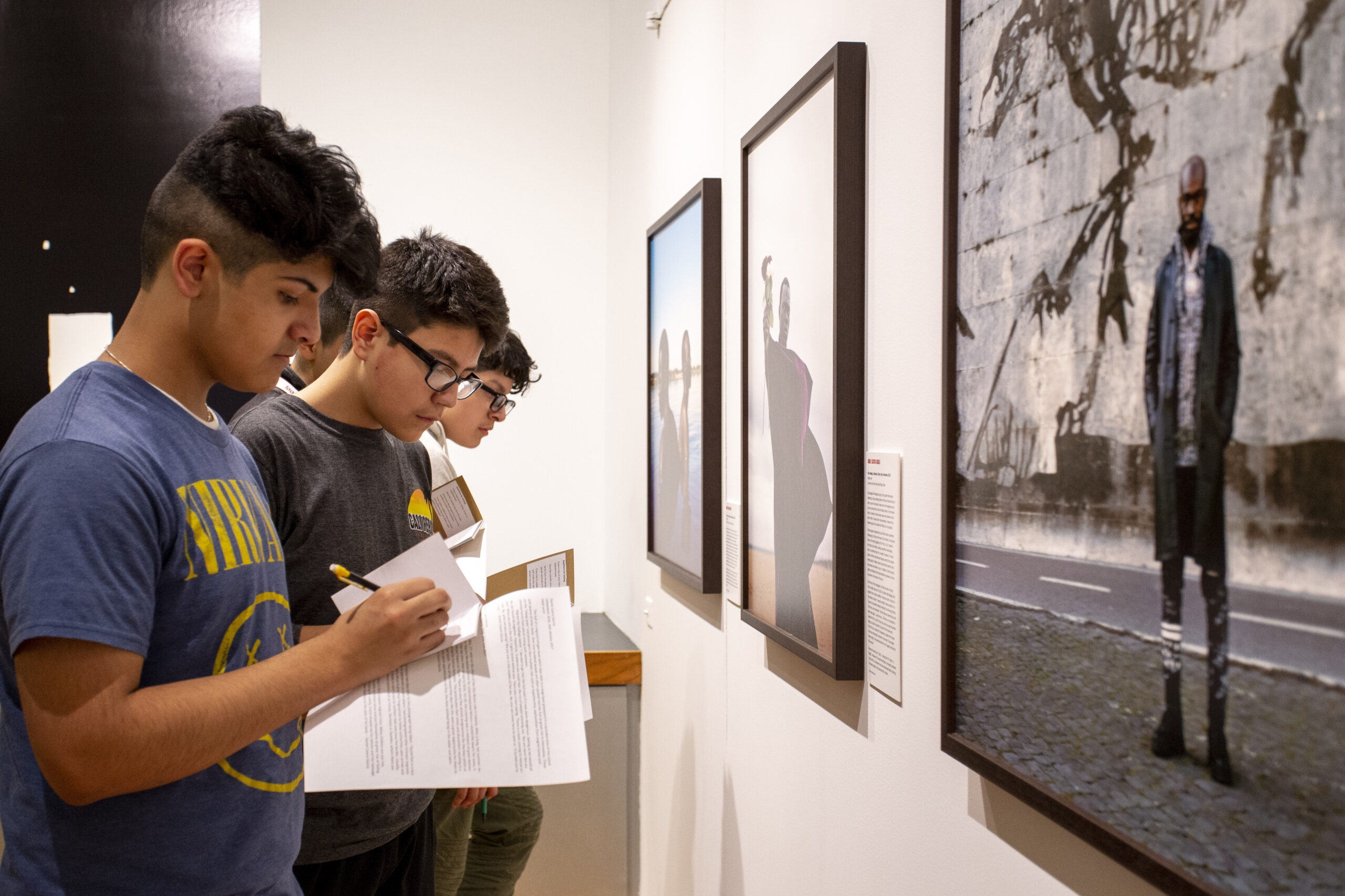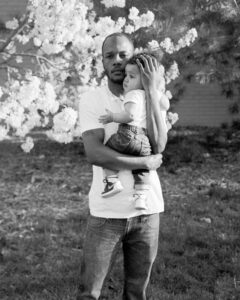
Art, Activism, Policy, Power: Guns in the USA
Art, Activism, Policy, Power is a learning framework created by the Museum of Contemporary Photography that provides resources and opportunities for in-person engagement with artists and activists. The program is designed to address different social justice topics, using the MoCP’s exhibitions, visiting artists, and collections as teaching tools. This framework aims to encourage students to uncover systemic structures that create injustices, to discover how artists use research in their practice to give voice to the pressing issues of their time, and to gain understanding of the power and relevance of the arts in advancing the work of activists. The resources here can be implemented and adapted by educators to fit a wide variety of curriculums.

Overview
AUDIENCE
9-12th Grade learners
TIME NEEDED
Two 90-minute field trips plus an additional 5-10 hours in the classroom for discussion and art making activities
MATERIALS + PREP REQUIRED
Access to cameras or smart phones is necessary for making activities. Inkjet printer access preferred, but not required. Ability to stream videos in the classroom or at home is preferred.
LEARNING OBJECTIVES
For students to form new understandings of the systems that create inequities in their city and across the nation, and for students to utilize the photographic medium as a tool to communicate their thoughts and feelings on the social issue addressed in the program.
VOCABULARY
Social Justice: the belief that all people should have equal access to basic needs and services, including healthcare, jobs, safety, and housing.
Systematic: examples of this term used in this program include “systemic racism” or “systemic poverty,” meaning the causes for certain inequities can be traced to long-term political, legal, or societal structures.

Activism
What does it mean to be an activist? Can art be a form of activism? What impact can art have in activist causes?
Activism is a practice that involves direct, persistent action for or against one side of a controversial issue. We can see many forms of activism all around us, ranging from environmental activists who call for politicians and
corporations to change existing policies and practices that contribute to climate change, to Black Lives Matter activists who took to the streets all over the United States in June of 2020 to call for police reform after the killing of George Floyd in Minneapolis, MN.
Questions for Discussion
- Where have you seen activists in action in your communities
- What are some of the many ways one could be an activist now? Does it mean marching in the streets? Calling elected representatives? Social media campaigns?
- What are some other ways to stand up for justice?

Activity
Using only a camera, have students create one image of protest. The image can be about any social justice cause of their choice, but the photograph must not include any text besides a title. How successfully are students able to communicate their messages through photography alone and in a single image? What was easy and difficult about the limitations of this assignment?
Introduction to the topic
This chapter of Art, Activism, Policy, Power highlights
ways that artists are working to raise public awareness
or engender a deeper understanding around issues
related to violence and gun ownership.
This program was created in conjunction with the 2021–2022 MoCP exhibition, American Epidemic: Guns in the United States. The artists featured in this program each have work in the exhibition about the role
of firearms in structural violence, poverty, systemic racism, and the police force. Each artist uses photography to explore the many repercussions of
rampant gun use in this country where there are an estimated 120.5 guns for every 100 people.1
1 BBC. (2021, April 8). America’s gun culture in charts. BBC News. https://www.bbc.com/news/world-us-canada-41488081.
Questions for Discussion
- What stands out to students about these videos? How are young people working to change gun policy?
- What are some of the differences you noticed about how people talk about this issue?
- What are some of the differing opinions on gun ownership you have seen or heard before?
- Has American gun culture impacted the ways students learn and feel safe in schools?
- How can young people make their voices heard about pressing social issues?

Virtual Field Trip: Andres Gonzalez & Carolyn Drake
On Thursday, October 14, 2021 artists and activists Andres Gonzalez and Carolyn Drake gave a special presentation on their work.
Andres Gonzalez discussed his project, American Origami, a six-year investigation into mass shootings in American schools over the past two decades. Carolyn Drake discussed her quilt made from 1,004 squares of fabric she cut from police uniforms that she ordered from eBay to visualize the number of police killings that occurred in the US in one year. Both artists will engage high school students in discussion around the research behind their practice as artists and activists and the ways they use different materials and approaches to turn stories and data into visual forms.


officers in 2019 (detail), 2020
Questions for Discussion
- Do you see these artists’ works in visual art as a form of activism?
- Do Gonzalez’s photographs add anything new to the conversation around school shootings that you had not thought about before? Would you know these images were related to school shootings without reading about his work and only seeing the images?
- How do Gonzalez’s images differ from images we see in the news about mass shootings?
- What words would you use to describe the style and look of Drake’s quilt? How do her choices in color tell a story about loss?

In the Classroom: Telling Stories with Photographs
Discuss how artists can use a mix of photographic approaches within one series and have students create five different images to tell one story.
Images should include the following: an object, a portrait, a landscape, a still life arrangement, and an abstract image.
Encourage students to experiment with the scale, color, and presentation of the images. Which approach most successfully communicates the story or event? Do the images read successfully as a grouping or are they better presented individually?

Virtual Field Trip: Zora J Murff
See Zora Murff discuss his project At No Point In Between, which considers violence in communities as a byproduct of the history of redlining in US cities and decades-long patterns of systematic discrimination refusing services to Black, low-income, and otherwise marginalized communities. Murff’s project reflects on the media spectacle of fast violence in communities, as well as the legacy of segregation as a form of slow violence. Portraying the roles of both citizens and police officers, Murff shows the myriad ways in which invisible policies continue to operate and negatively impact Black communities.


In the Classroom: Telling Stories with Photographs
What are some American social structures that might create conditions for concentrated violence in certain neighborhoods over others How does Murff express connections in his imagery between the topics of systemic racism and violence? What type of research did the artist conduct prior to making these images?
Murff says this project considers the ways photography can perpetuate violence on Black bodies and ideas of the “spectacle and shame.” What might the artist mean by this? What responsibilities do we have as image makers in telling stories and not perpetuating harmful narratives?
In the article from the previous page, Jonathan Metzl says: “The period after a mass shooting is often very telling. When the shooter is white, the context is the individual narrative – this individual disordered white mind. When the shooter is black or brown, all of a sudden the disorder is culture.
The narrative we tell then is about terrorism or gangs.” Consider this statement and the issues discussed in the article in relation to Zora Murff’s imagery. Do you see the conversation about race in the photographs? If so, how?
Activity
Inspired by the work of Zora J Murff, ask
students to create 10 photographs that tell
a story in a non-linear way. What does it look
like to make documentary work without a beginning, middle, or end?

Illinois Learning Standards
VISUAL ARTS STANDARDS
VA:Re7.2.K–12 Perceive and analyze artistic work. Visual imagery
influences understanding of, and responses to the world.
VA:Re8.K–12 Construct meaningful interpretations of artistic work. People
gain insights into meanings of artworks by engaging in the process of art
criticism.
VA:Re9.K–12 Apply criteria to evaluate artistic work. People evaluate art
based on various criteria.
VA:Cn11.K–12 Relate artistic ideas and works with social, cultural, and
historical context to deepen understanding. People develop ideas and
understandings of society, culture, and history through their interactions
with and analysis of art.
SOCIAL SCIENCES STANDARDS
SS.CV.1.9-12 Distinguish the rights, roles, powers, and responsibilities of
individuals and institutions in the political system.
SS.CV.6.9-12 Describe how political parties, the media, and public interest
groups both influence and reflect social and political interests.
SS.CV.8.9-12 Analyze how individuals use and challenge laws to address a
variety of public issues.
SS.H.3.9-12 Evaluate the methods utilized by people and institutions to
promote change.
SS.H.7.9-12 Identify the role of individuals, groups, and institutions in
people’s struggle for safety, freedom, equality, and justice.
SS.H.8.9-12 Analyze key historical events and contributions of individuals
through a variety of perspectives, including those of historically underrepresented groups.
SS.H.11.9-12 Analyze multiple and complex causes and effects of events
in the past.

